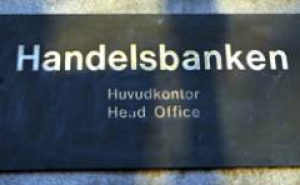Analys
Råvaror efter sommaren
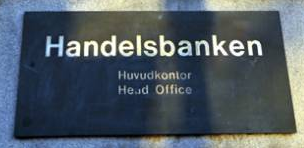
![]() Under sommaren har intresset för råvaror mest handlat om guld och silver i Rio de Janeiro. Det har dock inte hindrat råvarumarknaden från att röra på sig. Oljan har återhämtat sig till nära USD 50 och zink och nickel fortsätter springa ifrån övriga basmetaller. I veckans första brev efter sommaruppehållet sammanfattar vi läget för råvarorna och de teman vi tror man ska fokusera på under hösten.
Under sommaren har intresset för råvaror mest handlat om guld och silver i Rio de Janeiro. Det har dock inte hindrat råvarumarknaden från att röra på sig. Oljan har återhämtat sig till nära USD 50 och zink och nickel fortsätter springa ifrån övriga basmetaller. I veckans första brev efter sommaruppehållet sammanfattar vi läget för råvarorna och de teman vi tror man ska fokusera på under hösten.
Déjà vu för råolja
Den senaste återhämtningen i oljepriset från USD 40 till USD 50 har drivits av Saudis budskap om ett nytt möte mellan OPEC och Ryssland i september. Syftet med mötet ska vara att frysa produktionen. Marknadsreaktionen har varit kraftig och tolkar antagligen in förhoppningar på en sänkt produktion i steg två.
Vi tror att temat är mycket osäkert, hittills har det visat sig svårt för parterna att komma överrens. En sänkning av produktionen ser vi vidare som mycket osannolik. Det skulle i praktiken medföra att OPEC ger bort en marknadsandel till amerikanska producenter som just börjat vädra morgonluft efter prisuppgången under våren.
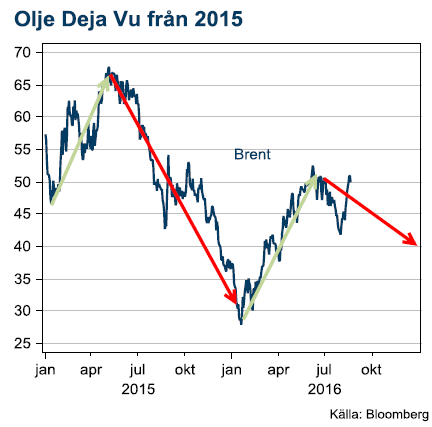 Det är ändock mer sannolikt att parterna når en överenskommelse om att frysa produktionen den här gången. Till skillnad mot förra försöket, i april så har Iran kommit upp i full produktion. Tillsammans med de övriga stora, Saudi och Irak i OPEC och Ryssland utanför OPEC ligger samtliga på eller nära sin rekordproduktion. Det talar för att ingen längre har något att förlora på att frysa produktionen. Samtidigt blir konsekvensen av att frysa på nuvarande nivåer snarare att marknaden tillförs mer olja än mindre. Saudiarabien har nämligen en stark säsongsvariation i sin inhemska oljekonsumtion. Den är som högts under sommarmånaderna då energibehovet för att kyla byggnader är som störst. Om man fryser produktionen på de här nivåerna kommer exporten att öka under kommande vinter när den inhemska efterfrågan når årslägsta.
Det är ändock mer sannolikt att parterna når en överenskommelse om att frysa produktionen den här gången. Till skillnad mot förra försöket, i april så har Iran kommit upp i full produktion. Tillsammans med de övriga stora, Saudi och Irak i OPEC och Ryssland utanför OPEC ligger samtliga på eller nära sin rekordproduktion. Det talar för att ingen längre har något att förlora på att frysa produktionen. Samtidigt blir konsekvensen av att frysa på nuvarande nivåer snarare att marknaden tillförs mer olja än mindre. Saudiarabien har nämligen en stark säsongsvariation i sin inhemska oljekonsumtion. Den är som högts under sommarmånaderna då energibehovet för att kyla byggnader är som störst. Om man fryser produktionen på de här nivåerna kommer exporten att öka under kommande vinter när den inhemska efterfrågan når årslägsta.
Oljemarknaden är fortfarande i överskott och vi tror att när uppståndelsen kring OPEC:s kommande extramöte lagt sig så kommer oljan återvända ner till USD 40.
Morgonluft i Texas
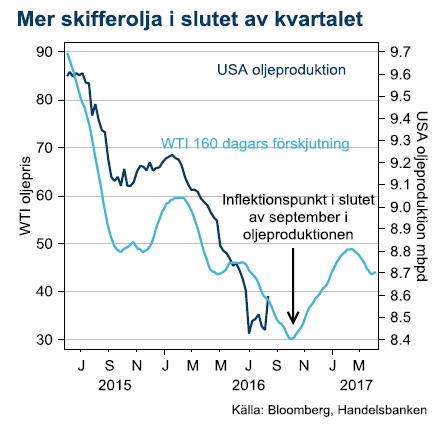 I skifferfälten börjar riggarna ställas tillbaka i produktion efter vårens prisuppgång. Under sju veckor i rad har antalet aktiva borriggar ökat med 80 stycken från en botten i juni på 316.
I skifferfälten börjar riggarna ställas tillbaka i produktion efter vårens prisuppgång. Under sju veckor i rad har antalet aktiva borriggar ökat med 80 stycken från en botten i juni på 316.
Pengar var flaskhalsen
Efter en lång period av för lågt oljepris var bristen på pengar i skifferbolagens kassor uppenbar. När priserna steg under våren gav det möjlighet att återuppta produktionen med förbättrad intjäning och tillgång till finansiella marknader. Fler borriggar behöver inte vara den bästa indikatorn på högre oljeproduktion men är ett uppenbart tecken på ökad aktivitet i oljefälten. Det finns massor med redan borrade hål som nu kan sättas i produktion när bolagen har bättre finansiell ställning och ökad produktion från dessa håll syns redan i den veckovisa produktionsstatistiken. Givet det samband som historiskt har gällt mellan en kraftig prisförändring och ökad eller minskad aktivitet i oljefälten så ska oljeproduktion öka i slutet av kvartalet. Produktionen ser redan ut att ha slutat falla så historien kommer sannolikt att upprepa sig.
Riskerna kommer från svaga länder
Vad vi lärt oss under våren är hur känsligt oljepriset blivit för störningar i de länder som lider av låga oljepriser. Nigerias produktion drabbades hårt när staten saknade medel att stödja grupper som snabbt tog till vapen för att förstöra produktionsanläggningar. I Venezuela råder vad som närmst bör beskrivas som en balansakt före kollaps. Dessa två länder ser vi som det största hotet mot låga energipriser. Om produktionen faller bort i något av dem är det tillräckligt för att föra oljemarknaden från överskott till brist.
Stål handlar fortfarande bara om Kina
Det fleråriga temat med kinesisk överproduktion har inte kommit mycket mer än halvvägs. Annonserade nedskärningar tas med en gäspning av marknaden som kräver att bli överbevisad snarare än att köpa på rykten.
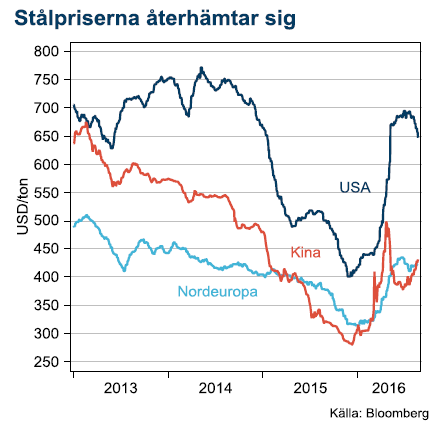 Trots det har saker och ting utvecklats annorlunda detta år. Priserna har stigit både i, och utanför Kina trots att exporttrycket från Kina inte har lättat såsom förhoppningarna var efter höjda tullar i USA och Europa. Istället är det den inhemska marknaden i Kina som förbättrats. Regeringen har stimulerat ekonomin för att dämpa nedgången. I den kampen har man använt sig av en gammal kär medicin, investeringar i infrastruktur. Därmed har prisbilden på stål stärkts och med högre inhemska priser krävs också högre priser på exportmarknaden vilket minskar prispressen från Kinas exportvolymer i USA och Europa.
Trots det har saker och ting utvecklats annorlunda detta år. Priserna har stigit både i, och utanför Kina trots att exporttrycket från Kina inte har lättat såsom förhoppningarna var efter höjda tullar i USA och Europa. Istället är det den inhemska marknaden i Kina som förbättrats. Regeringen har stimulerat ekonomin för att dämpa nedgången. I den kampen har man använt sig av en gammal kär medicin, investeringar i infrastruktur. Därmed har prisbilden på stål stärkts och med högre inhemska priser krävs också högre priser på exportmarknaden vilket minskar prispressen från Kinas exportvolymer i USA och Europa.
Under de senaste åren har Kinas minicykler blivit mer frekventa men varat allt kortare i tid. Regeringen agerar mer som brandmän än reformatorer. Vi tror därför inte att återhämtningen på stålpriserna blir så långvarig, kanske inte ens över årsskiftet. Det betyder en ny våg av prispress från Kina för Europa och USA under början av nästa år.
Basmetallerna stiger utan stöd från Kina
De divergerande utsikterna för basmetaller var något som vi uppmärksammade inför det här året. Nu syns tydligt effekterna av skiftande fundamenta i priserna. Zink har stigit 40%, nickel 15% samtidigt som koppar ligger kvar kring nollan.
Zink ligger i en lång stigande trend
En av de mer häpnadsväckande metallerna i år är zink. Till slut har zink tippat över i underskott i marknadsbalansen after att den ältade historien om utbrutna gruvor som stänger ner produktionen. Den första, Australiensiska Century levererade sin sista malm redan före jul men i en marknad som karaktäriseras av svag efterfrågan och höga lager så har det tagit lång tid före den lägre produktionen har gjort ett avryck i priserna.
När vi nu kommit dit tror vi inte att en uppsjö mindre gruvor står redo att öka produktionen för att kompensera. De senaste svältåren för gruvindustrin har gjort proaktiva, marknadsbaserade investeringar sällsynta. Underskottet på zink kommer sannolikt att växa och vi förutser en stark marknad under resten av 2016 och en bra bit in i 2017. Kinesiska smältverk har nyligen höjt betalningen för zinkkoncentrat från gruvorna med 20% till de högsta nivån på fyra år. Ett starkt tecken på den ökade konkurrensen om gruvornas produktion.
Nickel fick hjälp av ny president
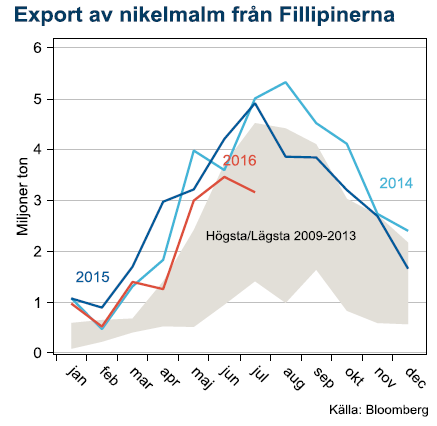 En av de minst väntade vändningarna det här året var nickel. Efter en prisnedgång på 63% sedan Indonesiens exportförbud drev upp priserna till en topp i början av 2014 har priset nu stigit 35% sedan botten i februari. Den här gången beror det inte på Indonesien utan Filipinerna, världens största producent. Landet fick en ny president i månadsskiftet juni/juli och den nya regeringen har gått hårt fram för att strama upp gruvindustrin enligt internationell miljöstandard. Det är en välbehövlig aktion, Filipinerna har tagit mycket av den marknad som Indonesien lämnade under exportförbudet men Filipinerna har ökat produktionen med spontant uppstartad primitiv produktion.
En av de minst väntade vändningarna det här året var nickel. Efter en prisnedgång på 63% sedan Indonesiens exportförbud drev upp priserna till en topp i början av 2014 har priset nu stigit 35% sedan botten i februari. Den här gången beror det inte på Indonesien utan Filipinerna, världens största producent. Landet fick en ny president i månadsskiftet juni/juli och den nya regeringen har gått hårt fram för att strama upp gruvindustrin enligt internationell miljöstandard. Det är en välbehövlig aktion, Filipinerna har tagit mycket av den marknad som Indonesien lämnade under exportförbudet men Filipinerna har ökat produktionen med spontant uppstartad primitiv produktion.
Med mindre produktion från Filipinerna och ett välkänt säsongsmönster där exporten faller dramatiskt under monsunperioden tror vi att det finns en uppsida för nickelpriset. I början av nästa år kommer inte exportvolymerna att öka såsom brukligt och därmed kommer en del av den kinesiska industrin som konsumerar malmen att svältas och tvingas köpa nickel från marknader prissatta mot LME.
Aluminium lyste starkt
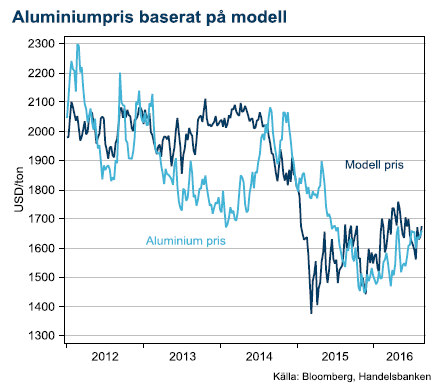 Lättviktsmetallen handlas omkring årshögsta, mestadels beroende på en svagare dollar och starkare oljepris. Modellen vi använder för aluminiumpriset stämmer just nu perfekt med rörelserna i USD och olja. Med vår tror på ett oljepris ner mot USD 40 så bör aluminium falla tillbaka till USD 1500-1550.
Lättviktsmetallen handlas omkring årshögsta, mestadels beroende på en svagare dollar och starkare oljepris. Modellen vi använder för aluminiumpriset stämmer just nu perfekt med rörelserna i USD och olja. Med vår tror på ett oljepris ner mot USD 40 så bör aluminium falla tillbaka till USD 1500-1550.
Koppar kommer i skymundan
Kärnan i basmetallgruppen har utvecklats klart sämst under året. Kopparpriset är i princip oförändrat trots att Kina har stimulerat ekonomin med den klassiska medicinen infrastrukturella investeringar som ökar efterfrågan på basmetaller. Ny produktion som kommer till marknaden från gruvor vars expansion ligger sent i supercykeln har kompenserat för att produktionsstörningarna i befintliga gruvor stigit till normala nivåer från väldigt låga nivåer under första halvåret.
Vi förväntar oss inte att kopparpriset ska återhämta sig, speciellt inte i ljuset av att de kinesiska stimulanserna kommer minska i betydelse under slutet av året.
Guld och silver efter OS
För ädelmetallerna är uppmärksamheten över efter att de olympiska spelen nått sitt slut. Sedan Fed blev mer mjuka i sin politik redan under våren finns det sannolikt inte mycket överraskningar på den mjuka sidan av räntepolitiken i USA. Brexit skapade den andra överraskningen som drev på guld och silver men nu är Brexit redan historia för de finansiella marknaderna. Vi tycker att det är svårt att hitta liknande drivkrafter framöver och tar en mer neutral syn på guld och silver efter årets kraftiga prisuppgång.
[box]SHB Råvarukommentar är producerat av Handelsbanken och publiceras i samarbete och med tillstånd på Råvarumarknaden.se[/box]
Ansvarsbegränsning
Detta material är producerat av Svenska Handelsbanken AB (publ) i fortsättningen kallad Handelsbanken. De som arbetar med innehållet är inte analytiker och materialet är inte oberoende investeringsanalys. Innehållet är uteslutande avsett för kunder i Sverige. Syftet är att ge en allmän information till Handelsbankens kunder och utgör inte ett personligt investeringsråd eller en personlig rekommendation. Informationen ska inte ensamt utgöra underlag för investeringsbeslut. Kunder bör inhämta råd från sina rådgivare och basera sina investeringsbeslut utifrån egen erfarenhet.
Informationen i materialet kan ändras och också avvika från de åsikter som uttrycks i oberoende investeringsanalyser från Handelsbanken. Informationen grundar sig på allmänt tillgänglig information och är hämtad från källor som bedöms som tillförlitliga, men riktigheten kan inte garanteras och informationen kan vara ofullständig eller nedkortad. Ingen del av förslaget får reproduceras eller distribueras till någon annan person utan att Handelsbanken dessförinnan lämnat sitt skriftliga medgivande. Handelsbanken ansvarar inte för att materialet används på ett sätt som strider mot förbudet mot vidarebefordran eller offentliggörs i strid med bankens regler.
Analys
Sell the rally. Trump has become predictable in his unpredictability

Hesitant today. Brent jumped to an intraday high of $66.36/b yesterday after having touched an intraday low of $60.07/b on Monday as Indian and Chinese buyers cancelled some Russian oil purchases and instead redirected their purchases towards the Middle East due to the news US sanctions. Brent is falling back 0.4% this morning to $65.8/b.

It’s our strong view that the only sensible thing is to sell this rally. In all Trump’s unpredictability he has become increasingly predictable. Again and again he has rumbled about how he is going to be tough on Putin. Punish Putin if he won’t agree to peace in Ukraine. Recent rumbling was about the Tomahawk rockets which Trump threatened on 10 October and 12 October to sell/send to Ukraine. Then on 17 October he said that ”the U.S. didn’t want to give away weapons (Tomahawks) it needs”.
All of Trump’s threats towards Putin have been hot air. So far Trump’s threats have been all hot air and threats which later have evaporated after ”great talks with Putin”. After all these repetitions it is very hard to believe that this time will be any different. The new sanctions won’t take effect before 21. November. Trump has already said that: ”he was hoping that these new sanctions would be very short-lived in any case”. Come 21. November these new sanctions will either evaporate like all the other threats Trump has thrown at Putin before fading them. Or the sanctions will be postponed by another 4 weeks or 8 weeks with the appearance that Trump is even more angry with Putin. But so far Trump has done nothing that hurt Putin/Russia. We can’t imagine that this will be different. The only way forward in our view for a propre lasting peace in Ukraine is to turn Ukraine into defensive porcupine equipped with a stinging tail if need be.
China will likely stand up to Trump if new sanctions really materialize on 21 Nov. Just one country has really stood up to Trump in his tariff trade war this year: China. China has come of age and strength. I will no longer be bullied. Trump upped tariffs. China responded in kind. Trump cut China off from high-end computer chips. China put on the breaks on rare earth metals. China won’t be bullied any more and it has the power to stand up. Some Chinese state-owned companies like Sinopec have cancelled some of their Russian purchases. But China’s Foreign Ministry spokesperson Guo Jiakun has stated that China “oppose unilateral sanctions which lack a basis in international law and authorization of the UN Security Council”. Thus no one, not even the US shall unilaterally dictate China from whom they can buy oil or not. This is yet another opportunity for China to show its new strength and stand up to Trump in a show of force. Exactly how China choses to play this remains to be seen. But China won’t be bullied by over something as important as its oil purchases. So best guess here is that China will defy Trump on this. But probably China won’t need to make a bid deal over this. Firstly because these new sanctions will either evaporate as all the other threats or be postponed once we get to 21 November. Secondly because the sanctions are explicit towards US persons and companies but only ”may” be enforced versus non-US entities.
Sanctions is not a reduction in global supply of oil. Just some added layer of friction. Anyhow, the new sanctions won’t reduce the supply of Russian crude oil to the market. It will only increase the friction in the market with yet more need for the shadow fleet and ship to ship transfer of Russian oil to dodge the sanctions. If they materialize at all.
The jump in crude oil prices is probably due to redirections of crude purchases to the Mid-East and not because all speculators are now turned bullish. Has oil rallied because all speculators now suddenly have turned bullish? We don’t think so. Brent crude has probably jumped because some Indian and Chinese oil purchasers of have redirected their purchases from Russia towards the Mid-East just in case the sanctions really materializes on 21 November.
Analys
Brent crude set to dip its feet into the high $50ies/b this week

Parts of the Brent crude curve dipping into the high $50ies/b. Brent crude fell 2.3% over the week to Friday. It closed the week at $61.29/b, a slight gain on the day, but also traded to a low of $60.14/b that same day and just barely avoided trading into the $50ies/b. This morning it is risk-on in equities which seems to help industrial metals a little higher. But no such luck for oil. It is down 0.8% at $60.8/b. This week looks set for Brent crude to dip its feet in the $50ies/b. The Brent 3mth contract actually traded into the high $50ies/b on Friday.

The front-end backwardation has been on a weakening foot and is now about to fully disappear. The lowest point of the crude oil curve has also moved steadily lower and lower and its discount to the 5yr contract is now $6.8/b. A solid contango. The Brent 3mth contract did actually dip into the $50ies/b intraday on Friday when it traded to a low point of $59.93/b.
More weakness to come as lots of oil at sea comes to ports. Mid-East OPEC countries have boosted exports along with lower post summer consumption and higher production. The result is highly visibly in oil at sea which increased by 17 mb to 1,311 mb over the week to Sunday. Up 185 mb since mid-August. On its way to discharge at a port somewhere over the coming month or two.
Don’t forget that the oil market path ahead is all down to OPEC+. Remember that what is playing out in the oil market now is all by design by OPEC+. The group has decided that the unwind of the voluntary cuts is what it wants to do. In a combination of meeting demand from consumers as well as taking back market share. But we need to remember that how this plays out going forward is all at the mercy of what OPEC+ decides to do. It will halt the unwinding at some point. It will revert to cuts instead of unwind at some point.
A few months with Brent at $55/b and 40-50 US shale oil rigs kicked out may be what is needed. We think OPEC+ needs to see the exit of another 40-50 drilling rigs in the US shale oil patches to set US shale oil production on a path to of a 1 mb/d year on year decline Dec-25 to Dec-26. We are not there yet. But a 2-3 months period with Brent crude averaging $55/b would probably do it.
Oil on water increased 17 mb over the week to Sunday while oil in transit increased by 23 mb. So less oil was standing still. More was moving.
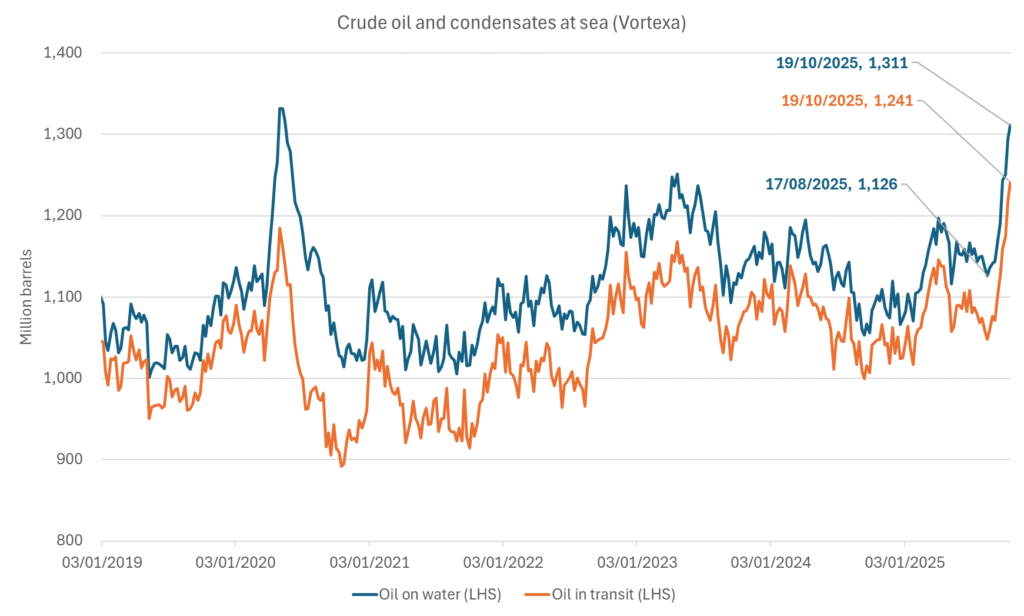
Crude oil floating storage (stationary more than 7 days). Down 11 mb over week to Sunday
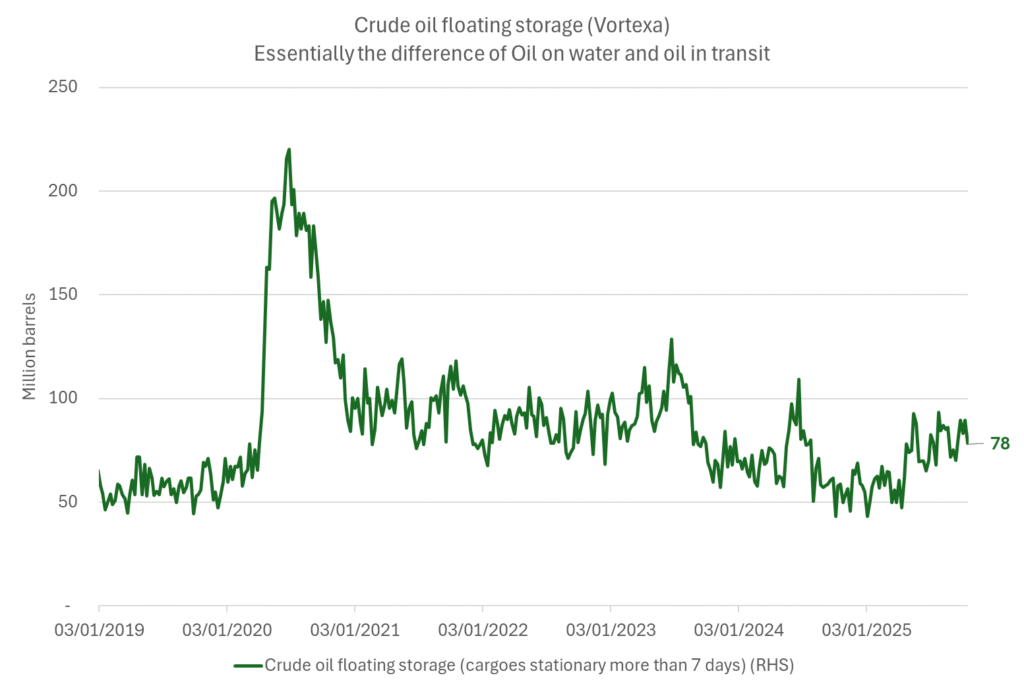
The lowest point of the Brent crude oil curve versus the 5yr contract. Weakest so far this year.
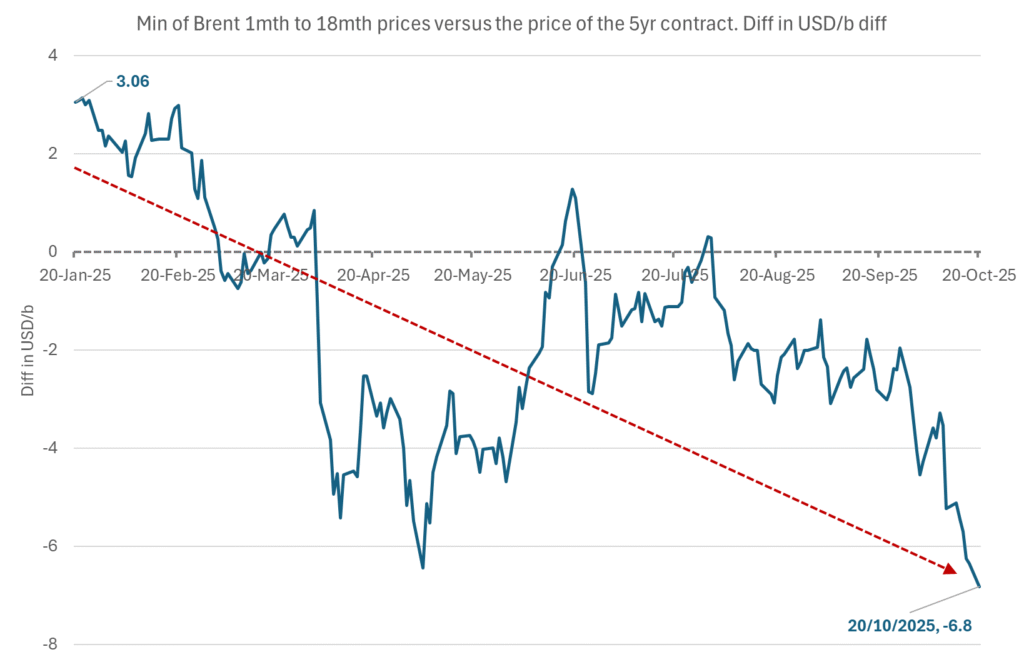
Crude oil 1mth to 3mth time-spreads. Dubai held out strongly through summer, but then that center of strength fell apart in late September and has been leading weakness in crude curves lower since then.
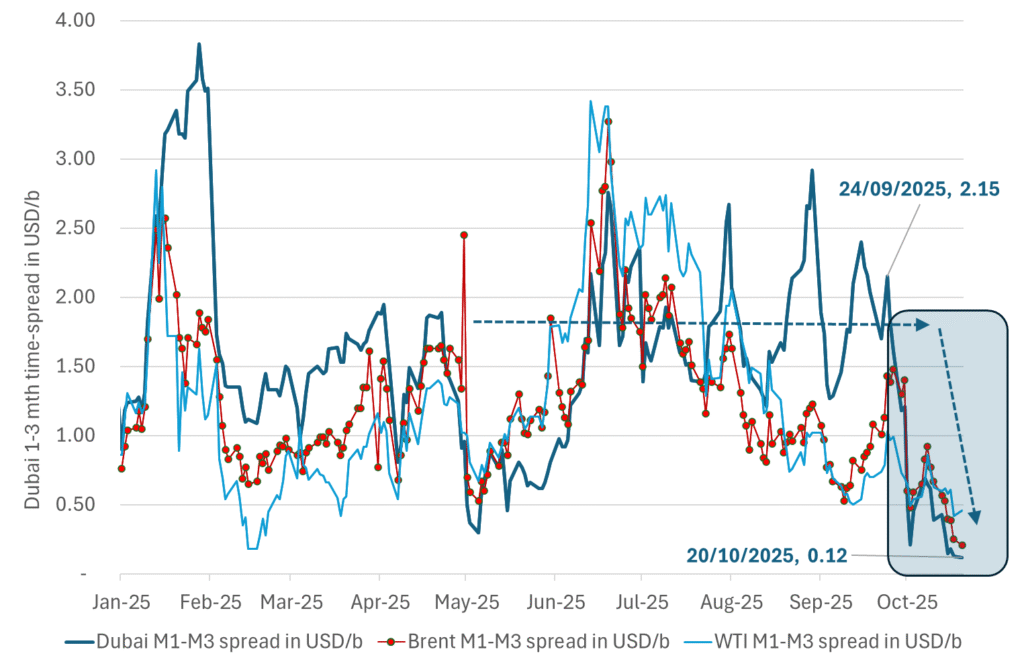
Analys
Crude oil soon coming to a port near you

Rebounding along with most markets. But concerns over solidity of Gaza peace may also contribute. Brent crude fell 0.8% yesterday to $61.91/b and its lowest close since May this year. This morning it is bouncing up 0.9% to $62.5/b along with a softer USD amid positive sentiment with both equities and industrial metals moving higher. Concerns that the peace in Gaza may be less solid than what one might hope for also yields some support to Brent. Bets on tech stocks are rebounding, defying fears of trade war. Money moving back into markets. Gold continues upwards its strong trend and a softer dollar helps it higher today as well.

US crude & products probably rose 5.6 mb last week (API) versus a normal seasonal decline of 2.4 mb. The US API last night partial and thus indicative data for US oil inventories. Their data indicates that US crude stocks rose 7.4 mb last week, gasoline stocks rose 3.0 mb while Distillate stocks fell 4.8 mb. Altogether an increase in commercial crude and product stocks of 5.6 mb. Commercial US crude and product stocks normally decline by 2.4 mb this time of year. So seasonally adjusted the US inventories rose 8 mb last week according to the indicative numbers by the API. That is a lot. Also, the counter seasonal trend of rising stocks versus normally declining stocks this time of year looks on a solid pace of continuation. If the API is correct then total US crude and product stocks would stand 41 mb higher than one year ago and 6 mb higher than the 2015-19 average. And if we combine this with our knowledge of a sharp increase in production and exports by OPEC(+) and a large increase in oil at sea, then the current trend in US oil inventories looks set to continue. So higher stocks and lower crude oil prices until OPEC(+) switch to cuts. Actual US oil inventory data today at 18:00 CET.
US commercial crude and product stocks rising to 1293 mb in week 41 if last nights indicative numbers from API are correct.
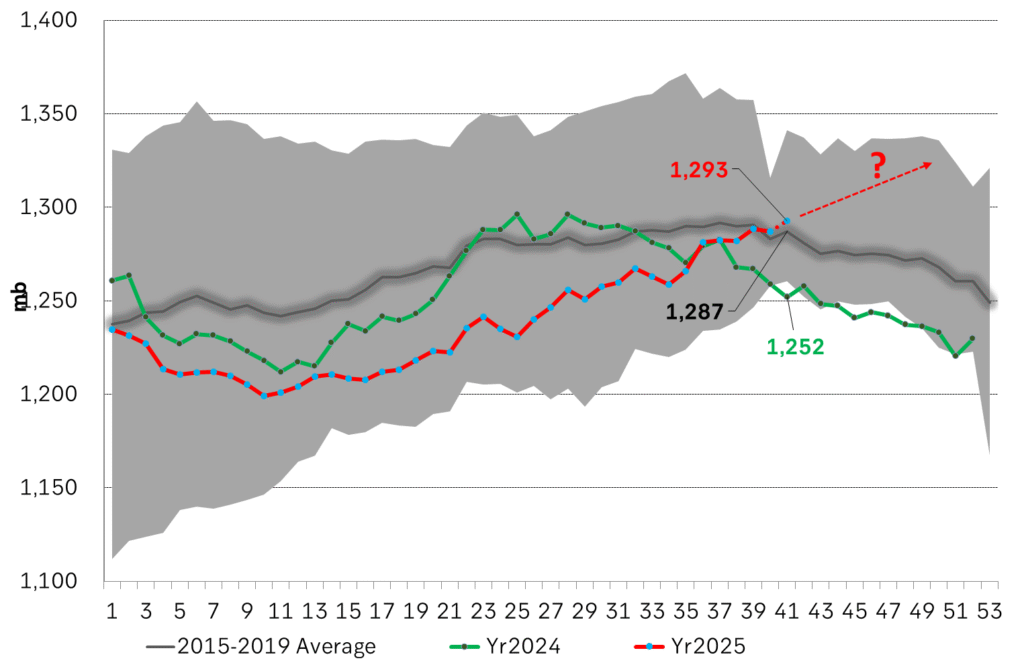
Crude oil soon coming to a port near you. OPEC has lifted production sharply higher this autumn. At the same time demand for oil in the Middle-East has fallen as we have moved out of summer heat and crude oil burn for power for air-conditioning. The Middle-East oil producers have thus been able to lift exports higher on both accounts. Crude oil and condensates on water has shot up by 177 mb since mid-August. This oil is now on its way to ports around the world. And when they arrive, it will likely help to lift stocks onshore higher. That is probably when we will lose the last bit of front-end backwardation the the crude oil curves. That will help to drive the front-month Brent crude oil price down to the $60/b line and revisit the high $50ies/b. Then the eyes will be all back on OPEC+ when they meet in early November and then again in early December.
Crude oil and condensates at sea have moved straight up by 177 mb since mid-August as OPEC(+) has produced more, consumed less and exported more.
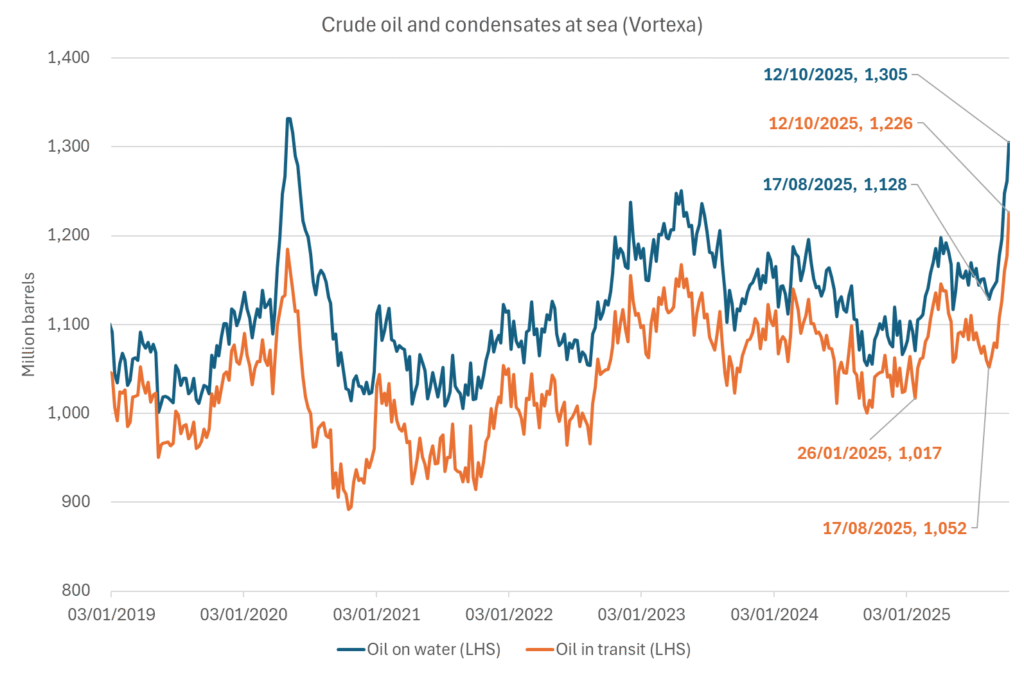
-

 Nyheter4 veckor sedan
Nyheter4 veckor sedanOPEC+ missar produktionsmål, stöder oljepriserna
-

 Nyheter2 veckor sedan
Nyheter2 veckor sedanGoldman Sachs höjer prognosen för guld, tror priset når 4900 USD
-
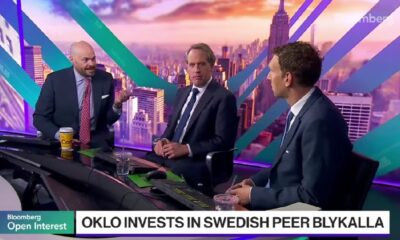
 Nyheter3 veckor sedan
Nyheter3 veckor sedanBlykalla och amerikanska Oklo inleder ett samarbete
-

 Nyheter3 veckor sedan
Nyheter3 veckor sedanGuld nära 4000 USD och silver 50 USD, därför kan de fortsätta stiga
-
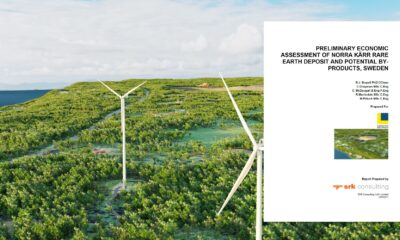
 Nyheter2 veckor sedan
Nyheter2 veckor sedanLeading Edge Materials är på rätt plats i rätt tid
-
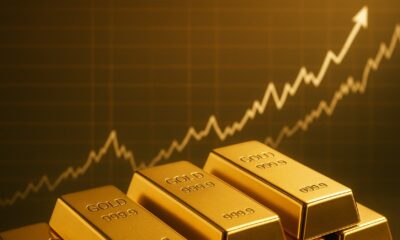
 Nyheter2 veckor sedan
Nyheter2 veckor sedanNytt prisrekord, guld stiger över 4000 USD
-

 Nyheter3 veckor sedan
Nyheter3 veckor sedanEtt samtal om guld, olja, koppar och stål
-

 Analys3 veckor sedan
Analys3 veckor sedanOPEC+ will likely unwind 500 kb/d of voluntary quotas in October. But a full unwind of 1.5 mb/d in one go could be in the cards



